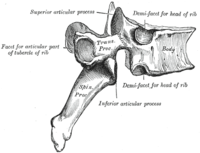
Photo from wikipedia
Background Degeneration of sacroiliac joints (SIJ) is common in the general population, which associates with age, gender and body mass index (BMI). This degenerative disease relates to various lumbar disorders.… Click to show full abstract
Background Degeneration of sacroiliac joints (SIJ) is common in the general population, which associates with age, gender and body mass index (BMI). This degenerative disease relates to various lumbar disorders. Lumbar facet joint osteoarthritis (LFJOA) is highly prevalent, but relationship between this disease and SIJ degeneration remains poorly evaluated. Objectives This study aimed to investigate the relation between LFJOA and SIJ degeneration. We hypothesized that LFJOA patients might suffer more serious SIJ degeneration, thus multiple linear regression was employed to compare the effect of LFJOA and demographic characteristics on degeneration of SIJ. Methods We reviewed pelvic and lumbar computed tomography (CT) examinations of LFJOA patient with low back pain (LBP) through a picture archiving and communication system. The controls were age, gender and BMI-matched individuals who were free of LFJOA and LBP, and underwent pelvic and whole abdomen CT scans due to the non-musculoskeletal symptoms. Severity of SIJ degeneration was scored using a quantitative method which has been descripted by Bäcklund et al [1]. LFJOA was graded using a method which has been mentioned by Weishaupt et al [2]. Briefly, this method concerns facet joint space, osteophytes, hypertrophy of the articular processes, and subarticular bone erosions, which ranges from 0 to 3 for a joint. If there is a discrepancy between 2 joints in the same level, the greater one was used. LFJOA was defined at least one level ≥2 from L1-2 to L5-S1. Scores of SIJ degeneration were compared between LFJOA patients and the controls. Correlation analysis between SIJ degeneration score and number of LFJOA levels, number of LFJOA joints, sum of LFJOA grades were performed. Stepwise multiple linear regression model was used to find the most important contributor of SIJ degeneration among LFJOA, gender, age and BMI. Results (1) CT examinations of 992 LFJOA patients and 399 controls were reviewed. (2) Score of SIJ degeneration in LFJOA patients were higher than that of the controls (8.85±2.94 vs. 4.31±2.52, P<0.05). (3) SIJ degeneration score positively correlated with number of LFJOA levels (r=0.11, P<0.05), number of LFJOA joints (r=0.09, P<0.05) and sum of grades (r=0.10, P<0.05). (4) Results of multiple linear regression were shown in Table 1. LFJOA had the greatest standardized coefficient in the regression model. Conclusion LFJOA patients suffers more significant SIJ degeneration, and more severe LFJOA leads to more serious SIJ degeneration. Influence of LFJOA on SIJ degeneration is stronger than demographic characteristics. References [1] Bäcklund J, Clewett Dahl E, Skorpil M. Is CT indicated in diagnosing sacroiliac joint degeneration? Clin Radiol 2017;72(8):693.e9-693.e13. [2] Weishaupt D, Zanetti M, Boos N, et al. MR imaging and CT in osteoarthritis of the lumbar facet joints. Skeletal Radiol 1999; 28: 215-219.Abstract THU0432 – Table 1 Stepwise multiple linear regression model for sacroiliac joints degeneration score Independent variables Unstandardized coefficient Standardized coefficient P value 95% confidence interval for B Variance inflation factor B SE Lower bound Upper bound LFJOA -4.49 0.12 -0.58 <0.001 -4.73 -4.25 1.00 Age 0.124 0.00 0.55 <0.001 0.12 0.13 1.01 BMI 0.05 0.01 0.06 <0.001 0.02 0.07 1.00 Gender 0.30 0.11 0.04 0.009 0.08 0.53 1.01 SE standard error, LFJOA lumbar facet joint osteoarthritis, BMI body mass index R 2=0.65, adjusted R 2=0.65 Acknowledgement None. Disclosure of Interests None declared
Journal Title: Annals of the Rheumatic Diseases
Year Published: 2019
Link to full text (if available)
Share on Social Media: Sign Up to like & get
recommendations!